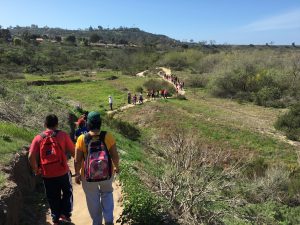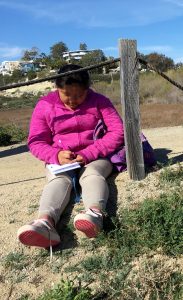Tale from the Field: Improving Teaching and Learning Through Shifts in Program Policies (2 of 2)
Tara Fuad and the San Elijo Lagoon Conservancy in San Diego, California, attended a BEETLES Leadership Institute in the summer of 2017. Tara has done a lot in the year and a half since attending the Institute and has used BEETLES materials and approaches to transform the way teaching and learning happens at her site.
Part 1 of an interview with Tara focused on changes she made to her organization to support student and nature-centered teaching at her site. Tara and her leadership team shifted policies to create spaces where students could go off trail, built lessons around natural features at her site instead of relying on props, integrated BEETLES resources, and restructured programming to increase students’ time outdoors.
Part 2 blog focuses on how Tara and shifted her organization model to be able to hire paid staff and continue to use BEETLES resources to build her program (and here’s Part 1 if you missed it last month!)
BEETLES: What are some of the other structural changes you made to your organization to support BEETLES implementation?
Tara Fuad: “After the Leadership Institute, we did the BEETLES Professional Learning Sessions Making Observations and Questioning Strategies for our volunteers (~20 of them). The volunteers were really engaged and enjoyed the professional learning sessions, but incorporating what they had learned into the school programs proved a little more challenging. We didn’t want to completely change our program in that first year, so we did a blend of our ‘old’ stations and the ‘new’ more free/open exploration approach. Naturally, this caused some confusion as some folks had totally bought into engaging with nature the whole time with students, while others still relied on the stations, and using props brought into the field. As the year went on, we started losing some of our regular volunteers as they said it was no longer clear what was expected of them.”
“By the end of the school year, there were only about 6-7 of the 20 volunteers who seemed fully on board with the new approach, even as we continued to hold monthly trainings focusing on using new techniques. I got the sense that the volunteers were just doing us a favor and sticking around to help us get through the school year, some leading up to 3-4 walks per week (as opposed to 1 walk per week, as was usual in the past). With the knowledge that the upcoming school year would be bringing even more students to our site as a second school district had signed up for our programs, I had to come up with a solution of how we would possibly cover the walks with up to 200 students per week. It was clear that we weren’t going to have enough volunteers to carry us through.”
“I explained the situation to our Executive Director, suggesting that we had reached the point where we needed to hire part-time staff to ensure our school programs were covered and were being implemented as envisioned. We made the difficult decision to shift from a volunteer-run program to hiring part-time staff. To cover the cost of hiring part-time staff, we decided to charge non-Title 1 schools $10/student (prior to that, all of our programs were free), and secured funds from local private foundations that supported outdoor nature/science experiences for youth. These foundations were familiar with our work and were willing to provide additional funds to ensure program growth and quality.
“At a volunteer meeting in June, we explained the direction of the new program and told the volunteers we would be hiring 10 part-time educators and encouraged everyone to apply. There was some disappointment among volunteers as they enjoyed the community, even if they hadn’t been volunteering much. By early August, we had hired 10 part-time educators and started training a couple of weeks later”
“The first day of training was filled with excitement and everyone was eager to learn and support one another. Because seven of the new educators had been our volunteers, they were already familiar with BEETLES techniques, which helped with the transition. We still started from the beginning with Making Observations and Questioning Strategies professional learning sessions, even though our ‘volunteer-turned-educators’ had received those trainings the year prior. Even though the educators had already experienced the sessions, repeating them reinforced the importance of these techniques and allowed the educators to reflect on their practices. I set clear expectations from the beginning ‘You have to be open-minded. You have to know you’ll be observed. You have to know our program is always going to be changing because we’re always going to be learning.’ On our first day of school visits I recall the educators all showing up early and running around with nervous energy and excitement. There was pride and ownership in our program that had been completely transformed to being truly student- and nature-centered.”
“We meet monthly for three hours and we always do something BEETLES-y, even if it’s not a full Professional Learning session. Sometimes we just watch a video and discuss it, or educators share ‘juicy’ questions or simple techniques that keep the students engaged and focused. Doing BEETLES techniques properly as an educator takes PRACTICE and PATIENCE, and with the volunteers who were somewhat in and out, it was hard for them to build on their skills. If they were out for a month or two due to vacation or whatever, when they came back it was like starting over. For our educators, we required that they be available to lead walks a minimum of 2-3/week, allowing plenty of opportunities to practice and master new skills.”
BEETLES: What advice would you give someone who is about to integrate BEETLES into their outdoor science organization?
Tara: “Take it slowly. As I started to implement, I realized I needed to be methodical with it. Making Observations is a good Professional Learning Session to start with. It’s outside, and it’s about pausing, slowing down, being present looking at the wonderment in nature anew. It’s great even if it’s similar to stuff you already do. Making Observations and Questioning Strategies are the basics, even if you just did those professional learning sessions your first year that would be amazing. In the fall I wanted to try Promoting Discussion, but after repeating Making Observations and Questioning Strategies, our educators asked to allow for some time to focus on and practice those skills and become more successful before adding something new. So I held off and waited until the spring to lead Promoting Discussion. Next year, I plan to do Field Journaling With Students and Teaching and Learning.”
“Engaging the chaperones is also important. We use the BEETLES Preparing Chaperones for Outdoor Science sheet to help the chaperones understand their role. We want to make sure they remain engaged, model curiosity and participate in the activities. If they are on board, they can make a big difference in helping the program run smoothly. We provide the chaperones with BFF (Best Friend Forever) questions from the BEETLES guide, Preparing Chaperones for Outdoor Science, make sure they have a hand lens, and include them in the toe-to-toe discussion circles and Walk & Talks. We also encourage them to journal with the students.”
“In terms of working within schools and the community, if your state has adopted the Next Generation Science Standards (NGSS), it’s a great opportunity to use your outdoor science program to help districts implement NGSS. Be familiar with and able to talk comfortably about NGSS and how environment-based learning and outdoor science programs directly support it. Be able to demonstrate and explain, “here’s how we’re engaging students in this kind of thinking, here’s how you’re using science practices and crosscutting concepts.” Districts are looking for support to implement NGSS.”
BEETLES: What changes in students’ responses to your program have you seen since implementing BEETLES?
Tara: “In outdoor education programs, it was expected that you go out to nature and people would tell you things you didn’t know or point out things you didn’t notice. Kids used to come to our program and say to our volunteers, ‘How do you know so much, how long did it take you to learn so many things?’ As I was trying to make the shift to student-focused learning, this was difficult to hear. “
“Now when I am out observing the programs, I hear students say ‘Nature is surprising,’ or ‘I thought this would be kind of boring, but I’m having fun.’ The teachers have responded well, too. When we asked the teachers at the end of the program about what surprised them, they said ‘The students were so interested in that log!!’
“Kids are having these personal experiences, getting immersed and curious. We’re creating curious folks. There’s all this buzz now about how grad schools want students who are curious, not students who have all the answers. We are thrilled to be starting that approach to learning with elementary students.”
BEETLES: Anything else you’d like to share?
Tara: “I would like to acknowledge my amazing colleague, Elayna Flanders, who attended the BEETLES Leadership Institute with me in 2017. I could not have made this shift without her positive attitude, hard work, and tireless support of our field educators.”





Leave a Response